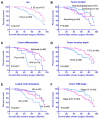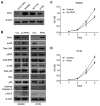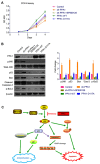PPA1 regulates tumor malignant potential and clinical outcome of colon adenocarcinoma through JNK pathways
- PMID: 28938583
- PMCID: PMC5601679
- DOI: 10.18632/oncotarget.17381
PPA1 regulates tumor malignant potential and clinical outcome of colon adenocarcinoma through JNK pathways
Abstract
Colorectal cancer (CRC) represents one of the most prevalent malignancies and the third leading cause of cancer death worldwide. Inorganic pyrophosphatase (PPA1) is an enzyme that catalyzes the hydrolysis of pyrophosphate to inorganic phosphate, therefore participates in the energy metabolism. Proteomic studies have demonstrated the up-regulated expression of PPA1 in various tumors, however, its expression pattern in CRC hasn't been reported. In the current study, we used RT-qCR, Western Blot and immunohistochemical (IHC) staining to explore the expression of PPA1 in 113 paired colon cancer tissues and adjacent normal tissues, which revealed that PPA1 was correlated with lymph node metastasis. The prognostic value of PPA1 was confirmed by Kaplan-Meier survival analysis and Cox regression analysis. We further purified PPA1 and obtained the phosphor-JNK1 protein and performed enzymatic studies, which identified that PPA1 can directly dephosphorylate pJNK1, while showed no catalytic activity towards pERK or p-p38 proteins. Moreover, overexpression of PPA1 enhanced cell viability through JNK-p53 signaling pathways, and it may also prevent cell apoptosis by inhibiting Bcl-2 and Caspase-3 cleavage. To our knowledge, this is the first study demonstrated the expression and clinical significance of PPA1 in colon cancer, which also provided evidence that figuring out PPA1 specific inhibitors can be invaluable in the future chemotherapy development towards colon cancer.
Keywords: JNK; PPA1; colon cancer; prognosis; proliferation.
Conflict of interest statement
CONFLICTS OF INTEREST The authors declare no conflicts of interest.
Figures






Similar articles
-
Expression of Inorganic Pyrophosphatase (PPA1) Correlates with Poor Prognosis of Epithelial Ovarian Cancer.Tohoku J Exp Med. 2017 Feb;241(2):165-173. doi: 10.1620/tjem.241.165. Tohoku J Exp Med. 2017. PMID: 28202851
-
PPA1, an energy metabolism initiator, plays an important role in the progression of malignant tumors.Front Oncol. 2022 Nov 25;12:1012090. doi: 10.3389/fonc.2022.1012090. eCollection 2022. Front Oncol. 2022. PMID: 36505776 Free PMC article. Review.
-
Inorganic pyrophosphatase (PPA1) is a negative prognostic marker for human gastric cancer.Int J Clin Exp Pathol. 2015 Oct 1;8(10):12482-90. eCollection 2015. Int J Clin Exp Pathol. 2015. PMID: 26722435 Free PMC article.
-
Pyrophosphatase 1 expression is associated with future recurrence and overall survival in Chinese patients with intrahepatic cholangiocarcinoma.Oncol Lett. 2018 May;15(5):8095-8101. doi: 10.3892/ol.2018.8278. Epub 2018 Mar 15. Oncol Lett. 2018. PMID: 29740496 Free PMC article.
-
Identification of Critical Elements for Regulation of Inorganic Pyrophosphatase (PPA1) in MCF7 Breast Cancer Cells.PLoS One. 2015 Apr 29;10(4):e0124864. doi: 10.1371/journal.pone.0124864. eCollection 2015. PLoS One. 2015. PMID: 25923237 Free PMC article.
Cited by
-
Deep learning based registration of serial whole-slide histopathology images in different stains.J Pathol Inform. 2023 Apr 23;14:100311. doi: 10.1016/j.jpi.2023.100311. eCollection 2023. J Pathol Inform. 2023. PMID: 37214150 Free PMC article.
-
Clinical significance and functional validation of inorganic pyrophosphatase in diffuse large B cell lymphoma in humans.Cytotechnology. 2018 Apr;70(2):641-649. doi: 10.1007/s10616-017-0165-5. Epub 2017 Dec 12. Cytotechnology. 2018. PMID: 29234945 Free PMC article.
-
Synthesis of Inorganic Pyrophosphatase-Nanodiamond Conjugates Resistant to Calcium and Fluoride.ACS Omega. 2020 Mar 20;5(12):6641-6650. doi: 10.1021/acsomega.9b04428. eCollection 2020 Mar 31. ACS Omega. 2020. PMID: 32258899 Free PMC article.
-
SIRT5-mediated desuccinylation of PPA2 enhances HIF-1alpha-dependent adaptation to hypoxic stress and colorectal cancer metastasis.EMBO J. 2025 May;44(9):2514-2540. doi: 10.1038/s44318-025-00416-1. Epub 2025 Mar 31. EMBO J. 2025. PMID: 40164945 Free PMC article.
-
Joint analysis of lncRNA m6A methylome and lncRNA/mRNA expression profiles in gastric cancer.Cancer Cell Int. 2020 Sep 25;20:464. doi: 10.1186/s12935-020-01554-8. eCollection 2020. Cancer Cell Int. 2020. PMID: 32982586 Free PMC article.
References
-
- Ferlay J, Soerjomataram I, Dikshit R, Eser S, Mathers C, Rebelo M, Parkin DM, Forman D, Bray F. Cancer incidence and mortality worldwide: sources, methods and major patterns in GLOBOCAN 2012. Int J Cancer. 2015;136:E359–86. - PubMed
-
- Liu H, Zhang Q, Li K, Gong Z, Liu Z, Xu Y, Swaney MH, Xiao K, Chen Y. Prognostic significance of USP33 in advanced colorectal cancer patients: new insights into β-arrestin-dependent ERK signaling. Oncotarget. 2016;7:81223–40. https://doi.org/10.18632/oncotarget.13219. - DOI - PMC - PubMed
-
- Mamounas E, Wieand S, Wolmark N, Bear HD, Atkins JN, Song K, Jones J, Rockette H. Comparative efficacy of adjuvant chemotherapy in patients with Dukes’ B versus Dukes’ C colon cancer: results from four National Surgical Adjuvant Breast and Bowel Project adjuvant studies (C-01, C-02, C-03, and C-04) J Clin Oncol. 1999;17:1349–55. - PubMed
-
- Fearon ER. Molecular genetics of colorectal cancer. Annu Rev Pathol. 2011;6:479–507. - PubMed
-
- Longley DB, Harkin DP, Johnston PG. 5-fluorouracil: mechanisms of action and clinical strategies. Nat Rev Cancer. 2003;3:330–38. - PubMed
LinkOut - more resources
Full Text Sources
Other Literature Sources
Research Materials
Miscellaneous

